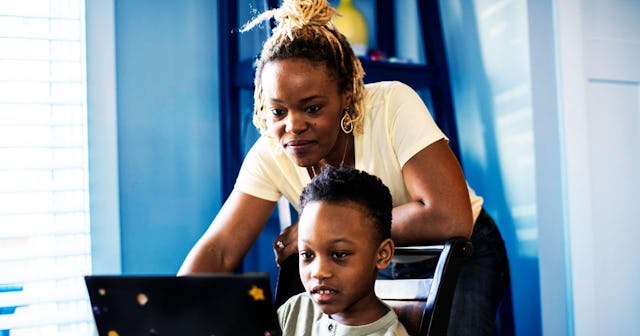Op Ed: Why All Schools Should Have A Virtual Option This Year

According to the CDC, almost 70% of kids received some kind of online learning last school year, and at least 45% started last school year with an entirely virtual option.
Yet, this school year, with COVID cases much higher than they were when school started last year, and many schools abandoning safety precautions like masks and distancing, most school districts around the country aren’t even offering parents virtual learning options.
As Stephanie Krejs, a mom from Dallas, TX, told CBS 11, when she found out that her district wouldn’t be offering virtual options this year: “I didn’t see this coming. I felt like they would have the same options that were available to all of the students last year.
I agree: they absolutely should. Every school district in America needs to continue offering virtual options to children until this pandemic is under control, and especially until all children under 12 are eligible for COVID-19 vaccines.
Now, many are going to come back at me and say, “But schools can be safe if they follow strict masking, distancing, and ventilation rules.” And you would be right! With correct measures in place, schools have proven to be low-risk environments for children.
Doctors Kanecia Zimmerman and Danny Benjamin Jr. provided ample evidence of this in a recent New York Times piece about the power of mask wearing in schools. “Although vaccination is the best way to prevent Covid-19, universal masking is a close second, and with masking in place, in-school learning is safe and more effective than remote instruction, regardless of community rates of infection,” they say.
In the article, the doctors described their investigation of the spread of COVID in North Carolina schools during last school year. They found that 7,000 kids and adults contracted COVID during that time and attended school while infected. More than 40,000 close contacts were quarantined; of those, only 363 ended up getting COVID.
MoMo Productions/Getty
“We believe this low rate of transmission occurred because of the mask-on-mask school environment,” the authors wrote. “Both the infected person and the close contact wore masks.”
This is awesome and definitely shows that masking can decrease the rates of COVID infection in schools. But, it doesn’t mean that masking can eliminate this. In other words, with proper safety measures in place, school can become a low-risk or lower-risk environment, but not a risk-free environment.
For many of us, the benefits of school for our children—especially after a year or more of no school or limited school—is enough for us to choose in-person school for our children. Yes, it might not be risk-free in terms of COVID, but nothing in life is, right? I think this is a reasonable gamble for many of us to take at this point in the pandemic, especially as many of us parents are vaccinated, as are many of our children’s teachers.
But that is not the case for some children. For children who are medically vulnerable or immunocompromised, or for kids who live with medically vulnerable or immunocompromised family members, “low risk” isn’t enough. Bringing the virus home simply isn’t an option. These children should not be denied an education.
Furthermore, with so many school districts going “mask optional” or banning masks completely, school is simply not low risk. It’s high risk. And we are at a point in the pandemic where more children than ever are hospitalized with serious cases of COVID. COVID is spreading like wildfire and it’s affecting our kids.
If schools can’t offer a low-risk, in-school environment for kids, they need to offer a virtual option, period.
Look, I’m as disappointed as anyone that this virus is still spreading, still causing major problems for us all, and having tragic outcomes. I truly thought school could be a much safer venture this school year. I also didn’t think that so many parents and leaders would lose their mind and decide that basic protections like mask wearing should be prohibited.
But here we are. Although some families actually prefer virtual learning (and more power to them!), most of us ultimately want our kids in school, interacting with their beloved teachers and peers. But this is a global pandemic, one that doesn’t look like it’s slowing down anytime soon.
Virtual education kept many of our kids learning, connected, and most of all—safe—last school year, and needs to continue to be an option this school year, too.
This article was originally published on